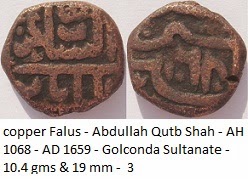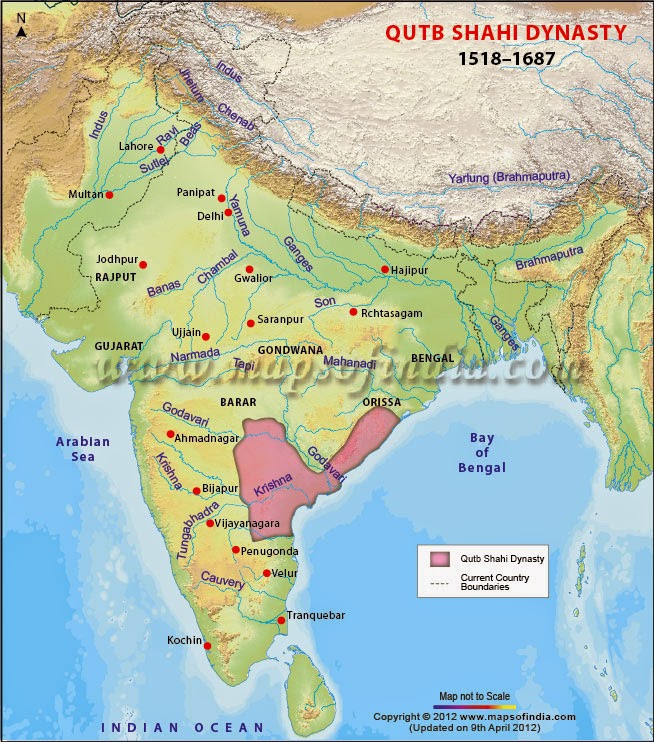SULTANATE
(Southern India)
7-GOLKUNDA SULTANATE
(Qutb Shahi)
A.H 895-1098 / A.D 1489-1687 (203 YEARS )
GOLKUNDA SULTANATE
The names of those sultans for whom coins are known ( * coin in collection)
1- Jamshid Qutb Shah AH 950 – 957 / AD 1543 – 1550
2- Subhan Qutb Shah AH 957/ AD 1550
3- Ibrahim Qutb Shah AH 957 – 988 / AD 1550 – 1580
4- Muhammad Quli Qutb Shah AH 988 – 1020 / AD 1580 – 1611
5- Muhammad Qutb Shah AH 1020 – 1035 / AD 1611 – 1626
6-* Abd Allah Qutb Shah AH 1035 – 1083 / AD 1626 – 1672
7-* Abu’l Hasan Qutb Shah AH 1083 – 1098 / AD 1672 – 1687
* * * * *
Map of Golkunda Sultanate
GOLKUNDA SULTANATE
When Bahmani ruler’s sovereign power was seized, after A.D 1518 the sultanate broke up into five states, By provincial governors, and founded new dynasties and sultanate, one of it Golkunda. The last fifth one dynasty was Imad Shahi of Berar (its coins not yet found.)
The Qutb Shahi sultanate developed from the disintegration of the Bahmani kingdom. Its founder was Sultan Quli, who came to the Bahmani court from Hamadan in Persia during the reign of Mhmud Shah. In A.D1496 he was appointed governor of Tilangana with the title Qutb al-Mulk, he also became responsible for the provinces of Golkonda and Warangal. He became independent in all but name. He remained loyal to Mahmud Shah as long as the latter lived, but upon his death, in A.D 1518, Qutb al-Mulk declared his independence. He made Golkonda his capital and renamed it Muhammadabad. Any coin struck at Golkonda must have continued quoting the name of Bahmani sultans, as no coins have been found with his own name.
Sultan Quli Qutb Shah had grown very old, when in A.D1543, his second surviving son, Jamsheed had him assassinated. Jamsheed is the first Sultan of Golkonda to have issued coins.
Aurangzeb could not tolerate the existence of Golkonda and keen to annex it. Golkonda fell to the Mughal in A.D 1687 (A.H 1098), Aurangzeb succeeded in capturing the fort of Golkona and king Abul Hasan Qutb Shah. State fell into the end.
CHARMINAR
Charminar
FACTS & FIGURES
Built in: 1591 AD
Built by: Mohammad Quli Qutb Shah (1580-1612) Golkunda Sultanate.
Location : In the city Hyderabad (State Andhra Pradesh)
(1) ABDULLAH QUTUB SHAH
(S/o King Muhammad Qutb Shah)


7-Golkunda Sultanate, Abdullah Qutb Shah /Coin-1
Ruler : Abdullah Qutb Shah
Year : A.H 1035-1083 / A.D 1626 – 1672
Denomination: 1/2 FALUS, Metal: Copper
Mint : Hyderabad Dar-us-sultanat,
Reference: Rajgor. 2028, Goron-Q.61, 7.7-8 g
Rarity : SCARCE
* * * * * * * * * *


7-Golkunda Sultanate, Abdullah Qutb Shah /Coin-2
Year : A.H 1035-1083 / A.D 1626 – 1672
Denomination: 2/3 FALUS, Metal: Copper
Date : Frozen date 1068 AH
Mint : Hyderabad Dar-us-sultana
Reference: Rajgor. 2043, Goron-Q.74, 6.8-7 g
* * * * * * * * * *
7-Golkunda Sultanate, Abdullah Qutb Shah /Coin-3
Ruler : Abdullah Qutb Shah
Year : A.H 1035-1083 / A.D 1626 – 1672
Denomination: FALUS, Metal: Copper
Mint : Hyderabad Dar-us-sultanat
Reference: Rajgor. 2045, Goron-Q.70, 11-12 g
* * * * * * * * * *


7-Golkunda Sultanate, Abdullah Qutb Shah /Coin-4
Ruler : Abdullah Qutb Shah
Year : A.H 1035-1083 / A.D 1626 – 1672
Denomination: FALUS, Metal: Copper
Mint : Hyderabad Dar-us-sultanat
Reference: Rajgor. 2049, Goron-Q.73, 10-11 g
* * * * * * * * * *


7-Golkunda Sultanate, Abdullah Qutb Shah /Coin-5
Ruler : Abdullah Qutb Shah
Year : A.H 1035-1083 / A.D 1626 – 1672
Denomination: FALUS, Metal: Copper
Date : Frozen date 1068 AH
Mint : Hyderabad Dar-us-sultanat
Reference: Same as above but lighter
* * * * * * * * * * *


7-Golkunda Sultanate, Abdullah Qutb Shah /Coin-6
Ruler : Abdullah Qutb Shah
Year : A.H 1035-1083 / A.D 1626 – 1672
Denomination: HALF FALUS, Metal: Copper
Mint : Hyderabad Dar-us-sultanat
Reference: Goron-Q.62, 6.1 g
Rarity : RARE
* * * * * * * * * *
(2) ABUL HASAN QUTB SHAH (Tana Shah)
A manuscript depicting the painting of Abul Hasan Qutb Shah the last ruler of the Golkonda Sultanate.


7-Golkunda Sultanate, Abul Hasan Qutb Shah /Coin-1
Ruler : Abul Hsan Qutb Shah
Year : A.H 1083-1098 / A.D 1672-1687
Denomination: FALUS, Metal: Copper
Date : 1095 A.H
Reference: Rajgor. 2056, Goron-Q75, 10-11 g
Rarity : SCARCE
* * * * * * * * * *


7-Golkunda Sultanate, Abul Hasan Qutb Shah /Coin-2
Ruler : Abul Hsan Qutb Shah
Year : A.H 1083-1098 / A.D 1672-1687
Denomination: 2/3 FALUS, Metal: Copper
Date : 1095 A.H
Reference: Same as above but square

















